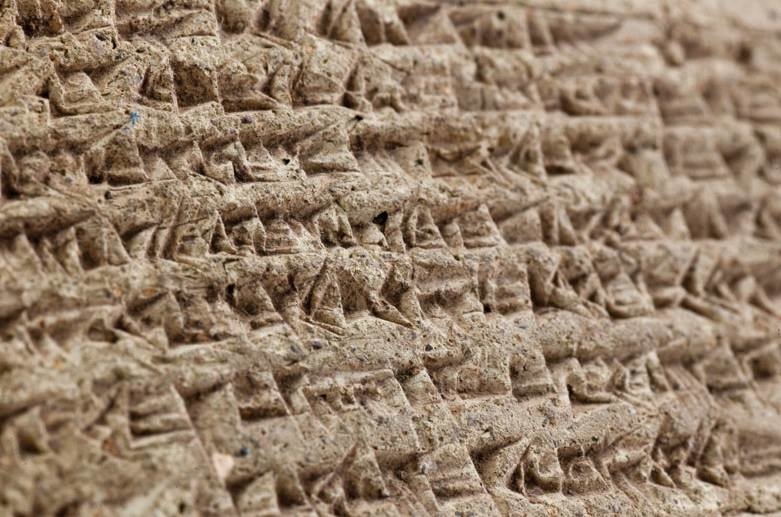The Romanian state is about to lose in the court of law a very precious Assyrian artifact, the so called Khorsabad Barrel or the Sargon Cylinder – reports the ziare.com news portal. The ancient object is actually an archaeological rarity, a cylinder made of burnt clay, which dates back to the 8th century B.C. It has been in the possession of the National History Museum of Romania (MNIR) since 1978. However, it seems that the antique treasure was not in fact acquired in a legal manner, and Ziare.com reports that there is an unprecedented claim for the asset. The heir of the former owner of the Khorsabad Barrel started the lawsuit against the Romanian Cultural Ministry, stating that the authorities got ahold of the treasure in an abusive way.
The antique cylinder with a length of about 23 centimeters, width of 11 centimeters, and height of 6.3 centimeters bares a text inscribed with cuneiform characters, regarding the rule of Assyrian King Sargon II (721 – 705 B.C.). It tells the story of his battles and conquests and makes note of his way of organizing and administrating the kingdom. The inscription also relates to the foundation of Sargon’s new capital, Dur-Sarukin, contains homage to the gods, and asks for their protection. The former “Fortress of Sargon” was located in what is today the village of Khorsabad in northern Iraq, 15 km northeast of Mosul.
Assyrian Kings used to place into the foundations or walls of newly erected or restored buildings various objects that contained messages to future generations – the Khorsabad Barrel is one such example. The texts inscribed usually contained phrases that honored the gods as well as curses to those who would commit an act of destruction.

The story of this ancient artifact is fascinating. It was a part of the archaeological inventory of the Khorsabad dig. According the MNRI’s information, the area had been archaeologically explored first in the early decades of the 19th century by the French consul of former Iraqi Kurdistan, Paul-Émile Botta. But in 1844, all digging ceased. In 1851, Victor Place, the appointed French consul in Mosul, addressed a request to the secretary of the Parisian Academy of Inscriptions, soliciting permission to continue the abandoned excavations. He was passionately interested in this work, and after several digging sessions, he discovered the residence of King Sargon II (721-705 B.C.). Place recounted the findings in a monumental work published between 1867–1870.
Built within the walls of the residence’s rooms and in the walls of a complex that served as a harem, Place had found a total of 16 barrels. Most of them had eight or 10 sides, but the one that ended up in the collection of the Romanian museum is unique: It has 9 sides. This was kept by the consul, whilst the other barrels lie right now at the bottom of the Tigris River, along with other artifacts; the raft that was taking them to France was attacked and then sunk by the perpetrators, as they were angry about not finding any precious metals.
Victor Place was appointed consul in Iaşi in 1855, where he stayed until 1863. He then carried out diplomatic mandates in Adrianopol, Calcutta, and New York. He was involved in a dilapidation scandal as well but was acquitted. In 1873, he returned to Romania with his wife and four children and passed away in Iaşi in 1875.
Time passed, and in 1974 his nephew, Lucien Raymond Place, offered the artifact for sale to the History Museum of the Socialist Republic of Romania. A note registered in the archives of the Cultural Ministry from 1978 states that lei 150,000 had been spent on acquiring the Khorsabad Barrel from Place. The arrival of the object was recorded in the museum on the 23rd of March 1978, and as the record says, it was “delivered” by Lucien Place, who died in 1987.
Fast forward to February 2015, and the sole heir of Place’s wife filed a lawsuit against the Ministry of Culture and the MNRI, claiming restitution of the precious object.
According to the complainant, the artifact was inherited by Lucien Place from the consul, and the state had taken it from him in an abusive manner. In the first forum, the Bucharest court ruled in favor of the ministry: in the decision pronounced on the 6th of June 2016, it was stated that the claim was not valid. The court had mostly taken into account the very proposition of Lucien Raymond Place himself to sell the precious object. The claimant did not give up, however, and contested the court’s ruling. She won the suit in the Bucharest Court of Appeals.
Judges determined that there was no evidence amongst the documents presented that would prove that there were any real negotiations between Place and the state, and there was also no valid proof of any payment, which should have followed a legal transaction. On the other hand, Place initially asked for lei 500,000 from the museum, which claims to have bought the artifact for the price of lei 150,000.
On the 18th of June 2018, the Court of Appeal admitted the request of the claimant and ruled for restitution of the Khorsabad artifact. But the ministry of Culture did not accept the decision and took the lawsuit to the highest judicial forum, the High Court of Justice. The trial is due to start this December, and this decision will be the final one…
Title image: This archaeological treasure is a memento of the rule of Assyrian king Sargon II.
Source: MNRI/Facebook